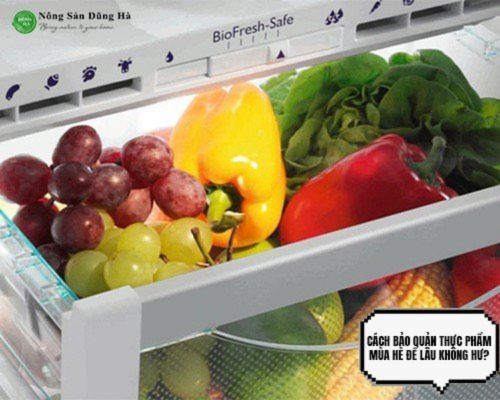Tin tức
[Pocket] How to preserve summer food for a long time without spoiling?
With the hot summer weather like today. The issue of how to properly preserve food to keep its nutritional value is a question many housewives are concerned about. The purpose of food preservation is to increase shelf life, avoid food spoilage as well as waste disposal. There are many methods of preserving food for this summer such as: cooling, freezing, smoking, vacuuming, preserving in a cool place, etc. Each product line is preserved differently. Let’s learn with dry agricultural products how to preserve summer food for a long time without spoiling.
1. What is food preservation?
Food preservation is the process of applying measures to maintain the quality, safety and prolong the shelf life of the product. This process involves the use of physical, chemical and biological methods to prevent the formation and growth of bacteria, molds, viruses and other harmful substances.
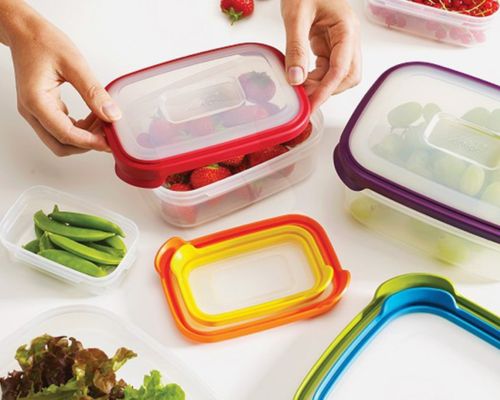
There are many different ways to preserve food, depending on the food and weather conditions. Currently, many foods are using food preservatives as a measure to prevent the spread of disease-causing bacteria. It also helps you prevent food poisoning. In addition to avoiding the attack of disease-causing bacteria, why do we need to preserve food?
See also: RECOMMENDATIONS 7 SIMPLE dinette menus for the SUMMER DAY
2. Why should food be stored properly?
- Ensure food safety: Food that is not stored properly can be contaminated with bacteria and mold. By proper storage, such as refrigeration or freezing, you will prevent bacterial growth and preserve food quality.
- Save money: Storing food properly will help prolong the shelf life of products. This will save you money by avoiding having to buy new food instead
- Maintain food quality: Storing food properly will also help products retain their quality, taste and nutritional value. This ensures that the food is always delicious and safe to use
- Convenience: Food storage also helps you always have food in the house to use at any urgent time. You can prepare in advance, saving shopping time
- Prevent the spread of disease: Some foods have the potential to cause disease when not stored properly. This way it helps to keep food in safe condition, reducing the risk of infection
3. How to preserve summer food for a long time without spoiling?
With today’s modern technology, perhaps preserving food seems to be somewhat easier. And perhaps, the refrigerator is your family’s companion throughout the years. The hot summer weather will make your family’s food very easy to ferment, stale, sour,… Let’s refer to it to know how!
3.1 How to store food in the fridge
Before you want to store food in the refrigerator. The first step you need to do is to clearly divide each product category together to avoid cross-contamination. Specifically:
3.1.1 With fresh food
- Wash and dry: Before placing in the refrigerator compartment. Make sure that the raw food has been washed to remove dirt, bacteria,… and drained.
- Sealed packaging: Place raw food in a zip-lock bag or food container with a tight-fitting lid to prevent exposure of air, odors, and bacteria. Please ensure that the packaging is clean and dry
- Separate compartment: Try to keep fresh food out of contact with other foods. You should use a separate compartment to clearly separate each product type to avoid cross-contamination
- Place in the refrigerator: Place fresh food in the refrigerator compartment. The ideal temperature for fresh foods is 2-7 degrees Celsius
- Reasonable arrangement: The food that you buy first, you should leave it outside for easy access. Food bought later, used later
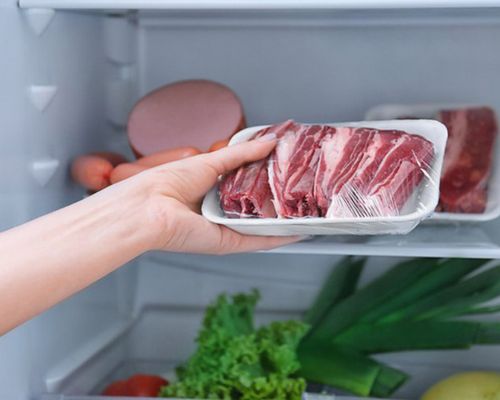
In addition to cold storage. You can completely store these fresh foods in the freezer with a temperature of -18 degrees Celsius and can extend the shelf life of the product to 1-2 months.
See more: Properly storing dried seafood – keeping all nutrients
3.1.2 With vegetables
- Wash: Before putting vegetables in the refrigerator, rinse them with water to remove dirt and bacteria. Completely remove damaged, rotten, and waterlogged parts
- Drying: Use a clean towel to completely dry the vegetables to avoid standing water that causes rot in the middle
- Wrap vegetables tightly: Put vegetables in ziplock bags, food containers with tight-fitting lids, or wrap vegetables with cling film to prevent moisture from contacting vegetables.
- Separation: If possible, keep vegetables separate and do not let them touch each other
- Quick use: Vegetables often have a shorter shelf life than other foods. It is recommended to use vegetables shortly after purchase to enjoy the full flavor and nutritional value

See more: [SECRET] How many calories are in dried vegetables? Eat a lot to get fat?
3.1.3 With fruits of all kinds
- Unripe fruits: To slow down the ripening process, you should keep fruits like mangoes, bananas, pears, apples, tangerines and oranges outside, in a dry place (not in the refrigerator). After ripening, you can store them in the refrigerator to increase shelf life
- Ripe fruits: Pineapple, plum, peach, tomato, orange,… usually ripen very quickly. These fruits are often very rotten. These fruits need to be stored in the refrigerator right away
- Hard Fruits: Fruits like pineapple, jackfruit, guava, grapefruit and watermelon usually keep well at room temperature for 2-3 days. To want to eat better, prolong the life, you can store it in the refrigerator
- Fruit slices or juice: If you have cut fruit into pieces or juice. Put them in an airtight food container and keep them in the fridge. Make sure to store tightly to avoid the effects of air and bacteria
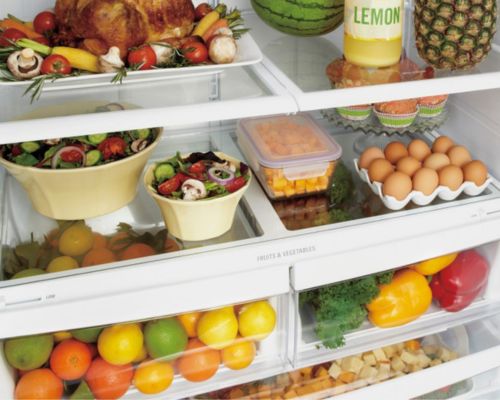
See more: [Tips] 5 Ways to make dried fruit flexible to eat without worrying about gaining weight
3.1.4 With dry goods
- Seal the container: Always make sure that all dry goods are tightly packed to prevent air, moisture, and insect entry. Use sealed bags, food containers with lids to prevent air exposure
- Store in a dry place: Dry goods should be stored in a cool, dry place. Avoid leaving them in a place that is humid or too hot
- Avoid sunlight: Place dry items out of direct sunlight. Light can discolor, reduce the quality of dry goods
- Proper storage: Nuts, dried fruits, spices, … can be stored in the cool compartment. However, there are some products that can absorb odors in the refrigerator. Please pack them tightly before storing them in the refrigerator
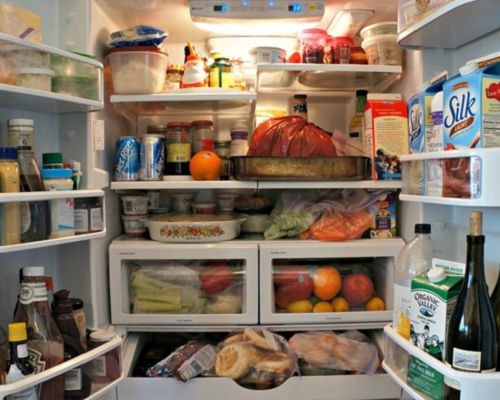
3.2 How to store cooked food in the freezer
According to the Food Safety Authority, cooked food is only safe for 2-3 hours. With a temperature of 27 – 55 degrees Celsius, food spoils very quickly. Many people believe that cooked food bacteria and viruses have been destroyed. But this view is completely wrong. Even though the food is cooked, if not stored properly bacteria can still multiply and grow normally.

- Sealed packaging: Always make sure cooked food is sealed tightly before placing it in the freezer. Use zip bags, food containers with tight-fitting lids
- Split portions: If you have a lot of cooked foods, break them up. This makes it convenient when you only need to take a small portion to use just enough
- Mark and date: When you put cooked food in the freezer. Please note the date of packing so you can track the most specific. This helps you avoid wasting food
- Proper temperature storage: To preserve the best cooked food. Please adjust the temperature between 1.7 and -5 degrees Celsius in the cooler. Freezer is about -18 degrees Celsius.
4. Other frequently asked questions about food preservation?
4.1 Should I put a lot of things in the fridge?
4.2 What is the appropriate food storage temperature in the refrigerator?
- Fresh foods: Fruits, vegetables, … should be stored at a temperature of 1 – 4 degrees C
- Meat and fish: Suitable temperature 0 – 2 degrees Celsius
- Milk (fresh milk, yogurt,…): The appropriate temperature is 2 – 4 degrees Celsius
- Eggs: Suitable temperature is 1 – 4 degrees Celsius
- Sweets: Suitable temperature is 3-7 degrees Celsius
4.3 Should the refrigerator be cleaned regularly?
- Daily cleaning: Clean the refrigerator daily by cleaning stains and plaque with warm water mixed with soap. Use a cotton cloth to clean the cabinet area
- Remove odors: If the refrigerator has bad odors, unpleasant odors,… You can use water mixed with white vinegar or lemon juice to wipe. Alternatively, you can put a cup of coffee powder or activated charcoal in the refrigerator
- Periodic inspection and cleaning: Check the refrigerator regularly to check the condition of the food and clean the interior space. Remove spoiled food, mold, waste,…
- Pack tightly: Make sure foods are tightly packed before putting them in the refrigerator. This helps to avoid spreading the smell of many foods together


 Tiếng Việt
Tiếng Việt